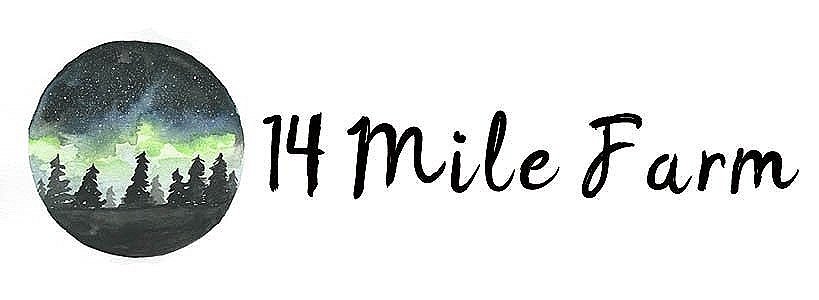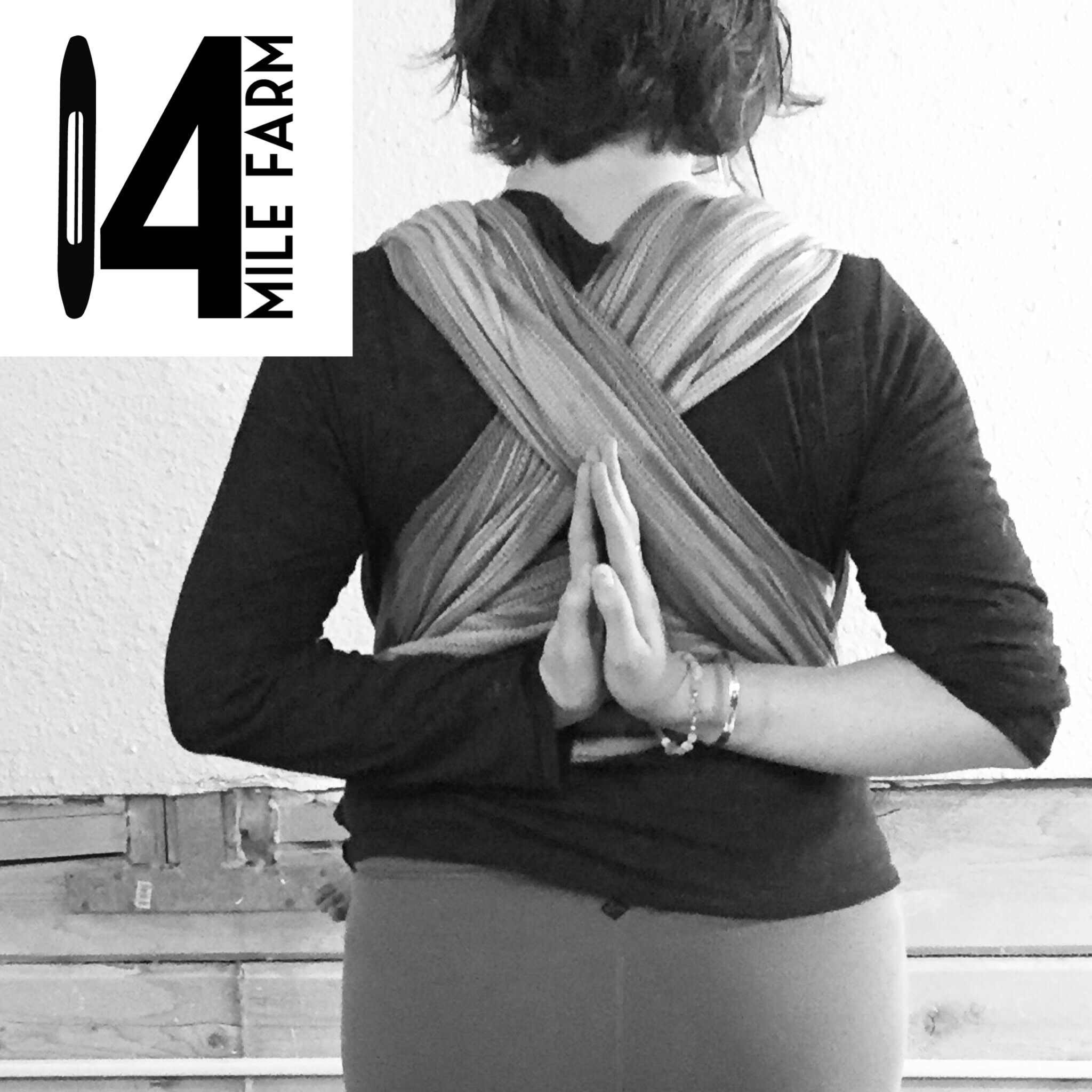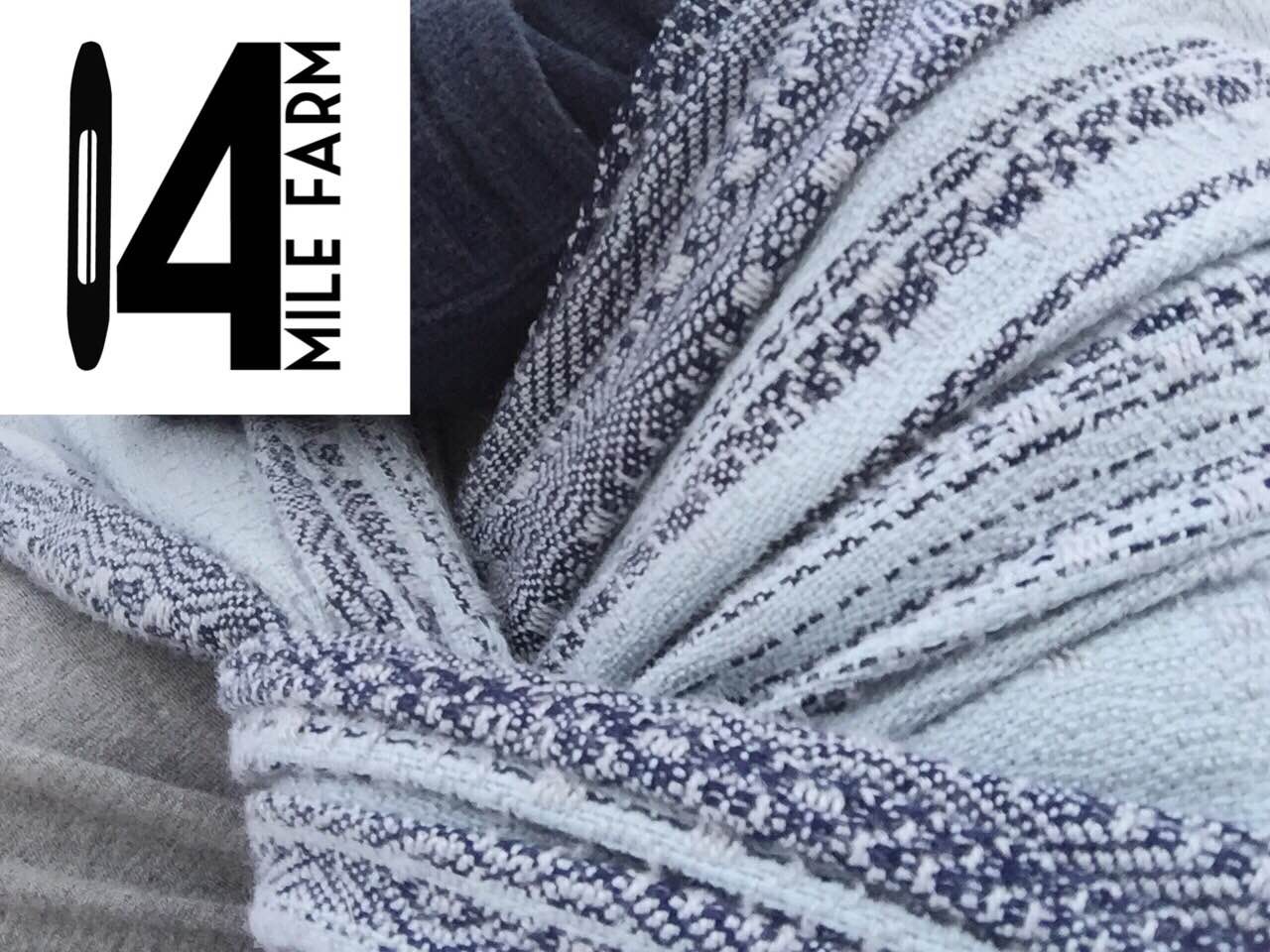Welcome! Please feel free to subscribe to the newsletter to get studio updates and projects from the archives straight to your inbox.
Surfacing: a story
Surfacing is 14 Mile Farm's tribute to the seal maidens in the folklore of my northwestern European heritage. I remember reading stories and tales of the Selkie as a child and they always left a taste of sadness, of longing, and great depth lingering like the taste of salt after a visit to the shore. As you may know, the Selkie is both seal and woman. She puts on her fur coat to swim with flippers amongst her kin and she takes it off to walk with legs on the land of men. She is a shapeshifter, living liminally between two worlds.
The sea speaks symbolically to our emotions, to the tidal pulls of love and desire or sadness and grief. In the same way that our inner workings of heart and soul may be invisible to the casual acquaintance, there are currents and cross currents, whole worlds unseen beneath the surface waves of the sea. The sea is a great Mother, nourishing all her children who live within and about her depths. She follows the pull of the moon, creating tides, just as woman's womb follows the cycles of waxing and waning in the night sky. The sea is deep, powerful, and ungoverned, as untameable as the soul.
The tales of the Selkie that I grew up on were tales of love and loss. The Selkie would doff her sealskin to become a comely lass with liquid brown eyes and dance naked on the sand. She would fall in love with a fisherman or a farmer, a handsome lad from the village. He would steal her sealskin and hide it in order to keep her on land. They marry and have children and are very happy. But as the years go by the woman grows first restless then sad, her eyes always drawn out to sea. Neither her children nor her husband can comfort her in this nameless grief. Then one day she finds her bundled sealskin where it was hidden by that handsome lad become loving husband. She unwraps it down by the shore, puts it on, and dives as a seal into the waves. Her children and their father mourn for her when she does not return. But from then on, on certain days, a seal with liquid brown eyes watches the family from the rocks on the shore.
As a child I was captivated and heartbroken by the pathos of this story. Now, as a mother and artist, I seek to bridge the worlds of shore and sea. The Selkie is drawn by that which is most integral to herself, she surrenders to the deep sea-pull on her soul.
This warp asks the questions: How can we honor the work of the woman's soul? How can we support her deep inner work without requiring the sacrifice of love and family life? How can we create a legacy for our daughters that does not demand they sacrifice either themselves or those they love? As mothers, how can we integrate the wild sea that pulls at the secret depth of the soul with the warmth of hearth fire and the home?
Surfacing will be woven in a network drafted twill evocative of waves. The warp is 100% long staple Egyptian cotton. There will be a variety of wefts including Seacell, Marine Silk, and 100% seaweed viscose. I'm so deeply pleased to be able to weave with seaweed for this particular project.
Artwork by Jessica Shirley. Buy an art print here.
Babywearing Yoga
I recently participated in a babywearing yoga challenge on Instagram. It was a lot of fun, and I even experimented with making video tutorials for the poses which you can check out on the 14 Mile Farm Facebook page.
Babywearing Yoga makes for great selfies and lets face it, it is a real nice ego boost to look so bad-ass on your social media. If, like mine, your feed is filled with fellow yogis doing poses that are still inaccessible to you after a decade of practice and fellow mamas posting about their aspirational parenting in your Facebook mom's groups, it can feel good to post a bunch of babywearing yoga selfies. Or, oh my, does SSS (that's stash shot Saturday in the babywearing world) just make you droolingly envious and make you wish you had one meeeellllion dollars to spend on wraps? Babywearing yoga selfies are a feel good one-upsmanship.
All ego-boosting humor aside, babywearing yoga has a whole host of benefits to offer mama and baby. In addition to the closeness, the bonding, the healthy attachment that babywearing supports, doing yoga poses with baby models mindful movement. We know that a baby's neurology is a sponge: picking up on and learning from everything in their environment. Specifically, babies' mirror neurons learn from what is modeled via mimicry. When a caregiver's physiology falls into yogic patterns of deep, still, smooth breath, calm parasympathetic nervous system, and its calm steady heartbeat - baby learns from that. Many babywearing yoga poses also have specific benefits for the postpartum mother's body that we will get into with more detail below.
Warrior One is a great pose to start out with, the first time you step onto the mat with baby on your back. This is also a posture that's easy to do with baby in a front carry, belly to belly with mom. Its an easy one to ease into babywearing yoga with, because its easy to incorporate into a walk or a wrap nap, no mats required!
Always be aware of your balance when practicing asana with baby on board. Feel your center of gravity extending down through tailbone and rooting to the earth beneath you. Be sure to keep the front knee directly over the ankle and in line with the toes for optimal stability for both you and your joints!
Warrior One is pose of strength and stability, it asks you to ground into your connection with the Mother Earth. At about 6 weeks post partum you can begin to consciously work on strengthening and engaging the muscles of the pelvic floor and the deep core. This pose is great for this work as it engages the muscles of thighs and legs and brings them on board to support the work of the core.
Utkatasana, or fierce pose, is also often known as chair pose. It is another one that may be easily practiced with babe on front.
This pose is the perfect invitation to work on the pelvic floor and core muscles as you deepen the sitting action. Be sure to keep breath soft in the belly, and find a fixed point upon which to focus the eyes. This practice, combining endurance, challenge, commitment, as well as the conscious softness and ease of deep breath is in some ways the perfect microcosm of motherhood.
Vrksasana or Tree pose is one of my all time favorite yoga poses ever. And it just gets better with baby! Babe can be on front, belly-to-belly, or in a back carry. The key is to have babe's weight centered on your body. Hip carries might not be the best option for this pose.
Tree pose, as with all balancing postures, is a practice of moving towards center. It is not necessarily a practice of resting in perfect stillness. When you feel yourself leaning towards one side, correcting towards the other side and overshooting center, swaying in the posture; the body is learning. Core muscles, hip muscles, foot muscles, are all mapping gravity, learning how best to keep you and babe's hearts centered and upright.
Plank pose, or the top of a push-up, is a pose that I only reccomend to practice if you you are proficient and comfortable with back carries. Baby on your front is maybe not a great idea for this posture. It is however a GREAT posture to work on core strength and deep stabilizing muscles. ** Please note that it is always a great option to come down onto the knees for this posture. It is better to maintain posture (especially through the lower and mid-back) and challenge yourself where you are at than it is to push into postures that are not sustainable.
The key here is to keep shoulders and hips in line with one another. It is really really easy, especially with the added weight of baby, to let the base of the ribs drop towards the floor. Instead think about broadening through the kidneys and lengthening through the low back. Your body will arrange itself in two lines here, spine and legs with a hing between the two. It is NOT the goal to make one unbroken line from head to heels.
If you cannot easily and freely breathe in the pose, modify it by coming onto the knees and choose to challenge yourself instead by holding it for a longer period of time.
Cobra pose or Seal pose (a deeper back bend, pictured here) is another posture that is only really appropriate with back carries. If you wear babe on the front, Camel pose (ustrasana) is a great alternative.
Practicing this pose properly and effectively requires active engagement of the core muscles. A supple pelvic floor and soft shoulders will also aid you.
Start with the entire front of the body on the floor. Hands are under shoulders, tops of feet, toes, tops of thighs and fronts of hips press downwards into the mat. Imagine the tailbone extending towards the heels. Let shoulder blades be soft underneath baby, behind the heart. Then using the hands as support, peel the torso off of the floor any amount. Hold the backbend for a breath or two or 5, and then slowly lower yourself back down.
Malasana, or Garland pose, is a deep squat that is hugely nourishing to the pelvic floor, perineal tissues and the digestive system. Feet and knees are slightly wider than the hips here, allowing the hips to sink between the knees. They can face in any direction that is comfortable so long as the knees and toes are pointing in the same direction. You'll notice that in the picture my feet are flat against the floor. If your heels do not comfortable rest against the floor simply tuck a rolled blanket or yoga mat underneath the heels so that the entire sole of the foot is able to active press into the ground. This allows the muscles of legs, hips and core to work optimally in the posture. This is another great one for exploring your center of gravity as you invite the tailbone to reach ground-wards and invite the spine to stack and elongate.
Did you know that children, babies especially, mirror the physiological state of their caregivers? This is actually true of adults and is a human neuro-physiological trait that therapists use to facilitate the healing work they do. When momma is stressed and freaking out, baby will not only pick up on that, but her heart will begin to mirror momma's increased heartbeat, baby's breath with mirror momma's becoming shallow. Likewise, we can use our physiological state - deep calm breaths for instance - to help calm a fussy child.
Yoga breath work is a great way to being to train our neurology and our physiology to settle into soothing state of deep calm and rest. When the body is familiar with a deep and easeful pattern of breath, it is a skillful tool that is more readily accessible in moments of stress - such as a tantruming child. Practicing breath work, therefore, is preparatory work for a gentle parenting approach.
Deep diaphragmatic breaths are perhaps the simplest yoga breath practice to begin with. My favorite however is Nadi Shodana (pictured), an alternate nostril breathing practice which balances the nervous system, calms mind and body, and nourishes the spirit.
Spark
Spark is a hadwoven babywearing wrap entered into the Spring 2016 Great Competition of Weavers.
In my head, Spark is one classy lady. She shines in pearls and high heels, elegant and poised. She loves a classic ensemble of blue jeans, a white t-shirt, sunglasses, and flats. She’s the kind of woman you admire from afar, wondering how on earth she manages to be all that she is and when you get to know her you are blown away by her kindness, her caring, and her warm hugs.
The Spring 2016 Great Competition of Weavers theme was “Under the Microscope.” This competition was only open to OOAK (one of a kind) wraps, so this is the only piece of Spark there ever was or ever will be. Spark is inspired by the process of mitosis.
As the daughter of a biologist, I have many fond memories of peering into the magical microscopic world contained in a drop of pond water. I was fascinated by “zoomers,” my childhood name for microbes that shot across the slide propelled by cilia or flagella or amoeboid movement. Yeast was particularly cool to watch, because of how FAST they multiplied! Dad was a PhD student in the early ‘90s and did much of his dissertation work on an electron microscope. It lived in its own room down the yellow linoleum hallway and I remember being SO impressed by it and by what could be seen through it. I was 5 years old. I remember the sheer magic of catching a “zoomer” when it was splitting in two, and it was this memory that I hoped to capture with “Spark.”
I considered a black/white/grey grad in homage to the images that we see through electron microscopes, but at least in my memory, the early behemoth of a microscope I stood on a stool to peer into gave a blue cast to its images, and I chose to show this in “Spark.”
Spark is woven in an overshot variation where the warp intersects with the tabby weft to make a ground of plainweave. In this particular variation there are actually a few picks of basketweave (basically a doubled thread plainweave) in this ground cloth. The pattern weft then floats over this ground to create the pattern. The ground of plainweave means that this is a very strong cloth even though the pattern weft has floats that are longer than would otherwise be optimal for the purposes of a baby wrap.
Funny story: when I first went to look at Maggie (my loom), her former owner – a weaver in her 80’s who had to retire from weaving due to degenerative arthritis in her hands - asked me what I was most excited to weave. I had just learned overshot in my weaving class and had fallen hardcore in love with the weave. I told her that I was most excited to weave overshot. Fast forward 8 or 9 years and this is the first full project that I’ve woven on it in overshot. There are always oh so many tempting projects!
I truly love this structure, and it is super fun and fascinating to see it come to life behind the passing of the shuttles but it is not a quick weave. After each pick, the weaver sets down one shuttle, picks up the other and throws it, making sure that the two wefts stay cleanly wound around each other along the selvedge. I set up my treadles so that my right foot was treadling the plainweave tabby picks, and my left foot was treadling the pattern picks. Each single pattern repeat required 74 steps on the treadles. I believe that I picked up speed the last meter or so, but I was averaging 10 inches per hour. And that’s based on an hour of strict weaving, no pauses to check my phone or nurse a baby or repair a broken thread!
I also love that the process of mitosis – the division and replication of one into two – speaks to this precious era of babywearing. This blink of time when our children are so very little is when they learn to identify themselves as themselves. Early childhood development experts talk about the process of individuation, that babies begin life with a recognition of mom as part of self and have to learn that they are actually two beings. Babywearing allows us to continue holding them as they undergo this transition into independence. The 4th trimester and the concept of the motherbaby dyad are biological and psychological realities that I wish were better understood and recognized by our culture.
Spark’s final measurements are 3.2 m stih weighing in at 280 gsm.She is woven with 16/2 cotton for the warp and tabby weft and 8/2 lyocelle (commonly known as Tencel) pattern weft.
If you are interested in following along more closely as things go onto and come off of my loom, please come join my Facebook group! I also post updates on Instagram.







































